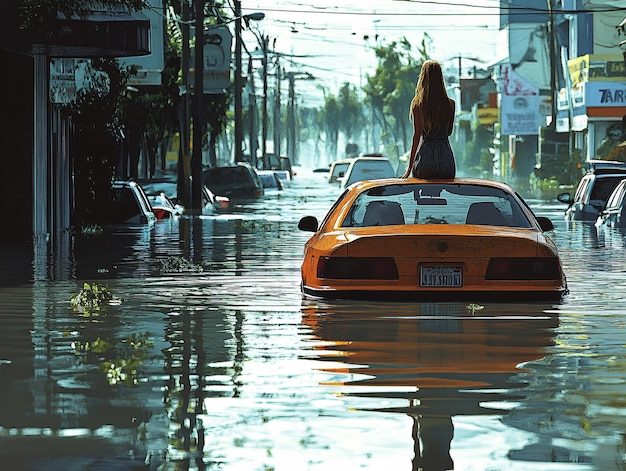Climate Change and Coastal Living: Preparing for Rising Sea Levels

Coastal communities face unprecedented challenges due to climate change, primarily from rising sea levels, necessitating proactive preparation and adaptation strategies to mitigate the impacts on infrastructure, ecosystems, and human lives.
The impending threat of rising sea levels due to climate change casts a long shadow over coastal living. Understanding the impact of climate change on coastal living: preparing for rising sea levels is no longer optional; it’s a necessity for homeowners, communities, and policymakers alike.
Understanding the Science Behind Rising Sea Levels
To grasp the complexities of climate change’s impact on coastal living, it’s crucial to first understand the science behind rising sea levels. This phenomenon isn’t just about melting glaciers; it’s a multifaceted issue driven by several key factors.
Thermal Expansion of Water
As the Earth’s temperature increases, the ocean absorbs a significant amount of this heat. Warmer water expands, a process known as thermal expansion, which contributes substantially to rising sea levels. Even seemingly small increases in water temperature can lead to noticeable changes in sea levels over time.
Melting Glaciers and Ice Sheets
The rapid melting of glaciers and ice sheets, particularly in Greenland and Antarctica, is another major contributor. These massive ice formations hold vast quantities of water, and as they melt at an accelerated rate, this water flows into the oceans, further elevating sea levels. The scale of this melting is unprecedented, and its impact is felt globally.
Other Contributing Factors
While thermal expansion and melting ice are the primary drivers, other factors play a role. Changes in land water storage (e.g., groundwater depletion) and shifts in ocean currents can also influence regional sea levels. Understanding these complexities is essential for accurate projections and effective mitigation strategies.
- Global Temperature Rise: The direct correlation between rising global temperatures and accelerated melting of ice.
- Impact on Coastal Ecosystems: How rising sea levels threaten coastal wetlands, mangroves, and other vital ecosystems.
- Socio-Economic Consequences: The potential displacement of communities and economic losses due to coastal erosion and flooding.
In summary, the science behind rising sea levels is complex, but the underlying drivers are clear. Thermal expansion, melting glaciers, and other factors are combining to create a significant threat to coastal communities worldwide. A comprehensive understanding of these processes is crucial for developing effective adaptation and mitigation strategies.
Immediate Impacts on Coastal Communities in the US
The impacts of rising sea levels are not a distant threat; they are already being felt in coastal communities across the United States. These immediate effects are disrupting lives, damaging infrastructure, and altering the very fabric of these communities.
Increased Flooding
One of the most visible consequences is the increased frequency and severity of flooding. Coastal areas that once experienced flooding only during major storms are now seeing it regularly, even during high tides. This “sunny day flooding” is becoming a common occurrence, disrupting daily life and damaging property.
Coastal Erosion
Rising sea levels are also accelerating coastal erosion, as higher water levels eat away at beaches and shorelines. This erosion threatens homes, businesses, and critical infrastructure, forcing communities to invest heavily in protective measures like seawalls and beach nourishment projects.
Saltwater Intrusion
Another significant issue is saltwater intrusion, where rising sea levels contaminate freshwater sources. This can affect drinking water supplies, agriculture, and ecosystems, posing a serious threat to the sustainability of coastal communities. The consequences of saltwater intrusion can be long-lasting and difficult to reverse.
The immediate impacts of rising sea levels are a wake-up call for coastal communities. Increased flooding, coastal erosion, and saltwater intrusion are already causing significant disruption and damage. Addressing these challenges requires a proactive and comprehensive approach.

Long-Term Projections for US Coastlines
While the immediate impacts of rising sea levels are concerning, the long-term projections paint an even more alarming picture. Understanding these projections is crucial for planning and preparing for the future of coastal living in the US.
Projected Sea Level Rise by 2100
Scientists project that sea levels could rise by several feet by the end of the century, depending on various climate change scenarios. Even under moderate emission scenarios, significant sea-level rise is unavoidable. The exact amount of rise will vary by region, but the overall trend is clear: coastal areas will face significantly higher water levels in the coming decades.
Impact on Coastal Cities
Major coastal cities like New York, Miami, and New Orleans are particularly vulnerable. These cities face the potential for widespread inundation, damage to infrastructure, and displacement of populations. The economic and social costs of adapting to these changes will be substantial.
Threats to Ecosystems
Coastal ecosystems, such as wetlands and coral reefs, are also at risk. Rising sea levels can drown these ecosystems, leading to habitat loss and reduced biodiversity. The loss of these natural buffers can further exacerbate the impacts of storms and flooding.
Economic Implications
The long-term economic implications of rising sea levels are staggering, encompassing property devaluation, increased insurance costs, and expenses related to relocation. Coastal tourism and fishing industries, vital to many local communities, will also face considerable challenges. These economic burdens necessitate strategic planning and investment in resilient infrastructure.
- Planning and Zoning: Implementing stricter building codes and land-use regulations in vulnerable areas.
- Infrastructure Investments: Investing in seawalls, levees, and other protective infrastructure.
- Community Engagement: Educating and engaging residents in the planning process.
The long-term projections for US coastlines are dire, but they also present an opportunity to act. By understanding the potential impacts and implementing proactive adaptation measures, coastal communities can mitigate the worst effects of rising sea levels and build a more resilient future.
Adaptation Strategies for Coastal Living
While mitigating climate change is essential, adaptation strategies are crucial for coastal communities to cope with the inevitable impacts of rising sea levels. These strategies involve a range of measures designed to protect people, property, and ecosystems.
Hard Infrastructure Solutions
Hard infrastructure solutions include building seawalls, levees, and other engineered structures to protect coastal areas from flooding and erosion. These solutions can be effective in the short term, but they can also be expensive and have negative impacts on coastal ecosystems.
Nature-Based Solutions
Nature-based solutions involve using natural features like wetlands, mangroves, and dunes to provide protection from storms and flooding. These solutions can be more sustainable and cost-effective than hard infrastructure, and they also provide additional benefits like habitat creation and carbon sequestration.
Managed Retreat
Managed retreat involves moving people and infrastructure away from vulnerable coastal areas. This can be a controversial strategy, but it may be the only viable option in areas facing extreme sea-level rise. Managed retreat requires careful planning and community engagement to be successful.
The choice of adaptation strategies will depend on the specific circumstances of each coastal community. A combination of hard infrastructure, nature-based solutions, and managed retreat may be the most effective approach. The implementation of these strategies needs to be well-coordinated and community-focused to ensure maximum effectiveness and acceptance.
Policy and Governance: The Role of Government
Effective policies and governance structures are essential for addressing the challenges of rising sea levels at the local, state, and federal levels. These policies can help to guide adaptation efforts, allocate resources, and ensure that coastal communities are prepared for the future.
Federal Initiatives
The federal government plays a crucial role in providing funding, technical assistance, and regulatory oversight for coastal adaptation. Agencies like FEMA (Federal Emergency Management Agency) and NOAA (National Oceanic and Atmospheric Administration) offer programs and resources to help communities prepare for and respond to sea-level rise.
State and Local Policies
State and local governments are responsible for implementing policies and regulations that address coastal hazards. This includes zoning regulations, building codes, and coastal management plans. Some states and cities have taken proactive steps to incorporate sea-level rise projections into their planning processes.
International Agreements
International agreements like the Paris Agreement are crucial for reducing greenhouse gas emissions and mitigating climate change. While these agreements are not directly focused on coastal adaptation, they are essential for addressing the underlying drivers of rising sea levels.
Effective policy and governance require collaboration across all levels of government and engagement with stakeholders. By working together, communities can develop and implement comprehensive strategies to address the challenges of rising sea levels and protect the future of coastal living.
Personal Actions: Protecting Your Home and Family
While government policies and community-level adaptation efforts are crucial, individual actions can also make a significant difference in protecting homes and families from the impacts of rising sea levels.
Home Elevation
Elevating your home can protect it from flooding and reduce the risk of damage. This is a significant investment, but it can be a worthwhile one in areas prone to flooding. Consult with local experts to determine the best elevation strategy for your property.
Flood Insurance
Purchasing flood insurance is essential for homeowners in coastal areas. Standard homeowners insurance policies typically do not cover flood damage. The National Flood Insurance Program (NFIP) offers flood insurance to homeowners, renters, and business owners in participating communities.
Emergency Preparedness
Developing an emergency preparedness plan can help you and your family stay safe during a flood or other coastal disaster. This includes creating an evacuation plan, assembling a disaster kit, and staying informed about local weather conditions. Regular drills and updates to the plan are also beneficial.
Taking personal actions to protect your home and family is a responsible and proactive step in the face of rising sea levels. By elevating your home, purchasing flood insurance, and developing an emergency preparedness plan, you can reduce your risk and increase your resilience.
| Key Aspect | Brief Description |
|---|---|
| 🌊 Rising Sea Levels | Driven by thermal expansion and melting ice, posing an imminent threat. |
| 🛡️ Adaptation Strategies | Include hard infrastructure, nature-based solutions, and managed retreat. |
| 🏠 Personal Actions | Home elevation, flood insurance, and emergency preparedness. |
| 🏛️ Policy & Governance | Essential for guiding adaptation, allocating resources, and ensuring community readiness. |
Frequently Asked Questions
▼
Rising sea levels are primarily caused by thermal expansion of water and the melting of glaciers and ice sheets due to increasing global temperatures driven by climate change.
▼
Coastal communities will face increased flooding, coastal erosion, saltwater intrusion, and potential displacement of populations. Infrastructure and ecosystems will also be at risk.
▼
Adaptation strategies include hard infrastructure solutions like seawalls, nature-based solutions using natural features, and managed retreat, which involves relocating from vulnerable areas.
▼
Individuals can elevate their homes, purchase flood insurance, and develop comprehensive emergency preparedness plans to mitigate the impact of rising sea levels on their properties.
▼
The government plays a crucial role in providing funding, technical assistance, and regulatory oversight for coastal adaptation efforts. They also develop and implement policies to address the issue.
Conclusion
Preparing for the impact of climate change on coastal living requires a multi-faceted approach, encompassing scientific understanding, community adaptation, governmental policies, and individual actions. By working together, coastal communities can build a more resilient future in the face of rising sea levels.





